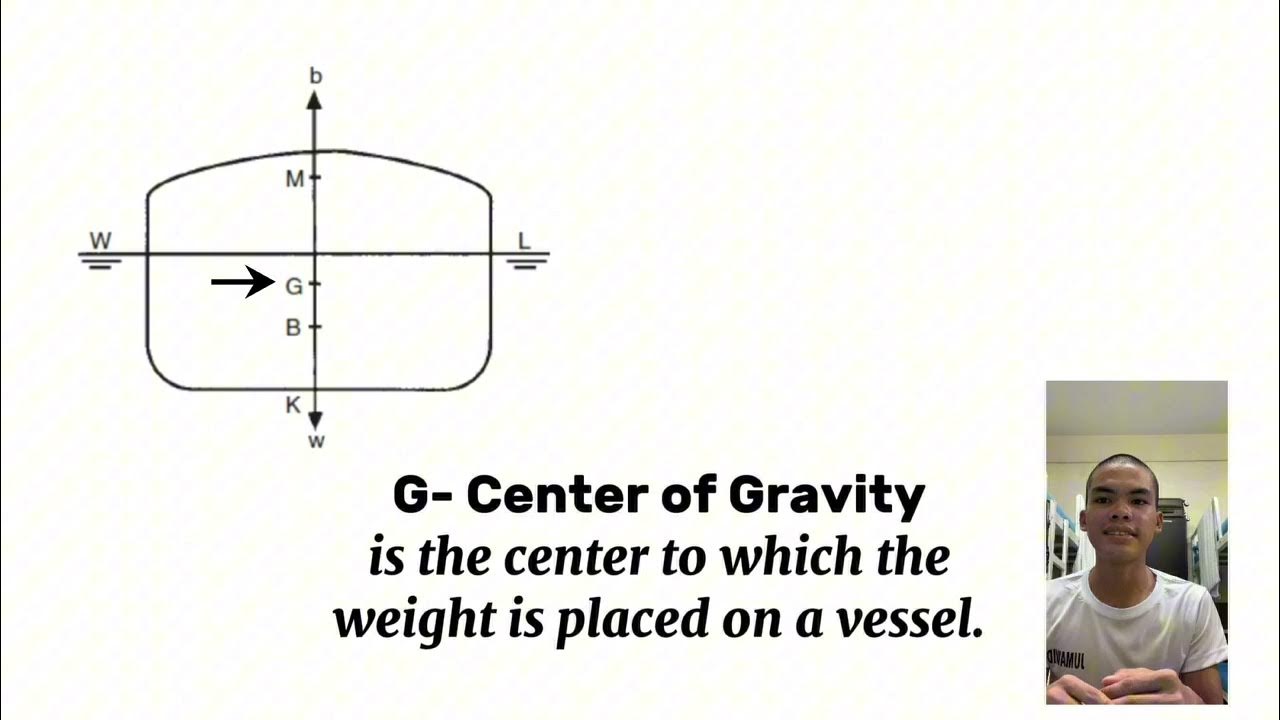Calculate Fluid GM l Multiple Weight I Initial Metacentric height l Final KG l Stability Calculation
Summary
TLDRIn this tutorial, the process of calculating a ship's KG (center of gravity) and GM (metacentric height) is explained in detail, focusing on how to account for various cargoes and ballast water. The video covers essential calculations, such as the initial displacement, vertical moments, and the effect of free surface moments in slack tanks. The final steps show how to determine the effective GM, ensuring it meets intact stability criteria. The comprehensive guide provides viewers with the necessary formulas and explanations to perform these crucial calculations for safe and stable ship operation.
Takeaways
- 😀 The video explains how to calculate a ship's KG (vertical center of gravity) and initial metacentric height (GM).
- 😀 The process involves handling a multiple weight problem, considering cargo loading, discharge, and free surface moments from slack tanks.
- 😀 The ship's initial displacement is given as 7,200 tons with an initial KG of 6.82 m.
- 😀 Cargo is loaded and discharged at different weights and vertical center of gravity (VCG), which contribute to the final displacement and moment.
- 😀 The free surface moment is calculated for ballast water in the four peak tank, using a sounding table and correcting for relative density.
- 😀 To calculate the final displacement, add the loaded weight and ballast water while subtracting the discharged weight.
- 😀 The final vertical moment is calculated by combining all positive moments and subtracting negative (discharged) moments.
- 😀 The final KG is determined by dividing the final vertical moment by the final displacement.
- 😀 The fluid GM is found by subtracting the final KG from the KM value (from the hydrostatic table).
- 😀 The calculated fluid GM is positive (0.196 m), indicating that the ship is in stable equilibrium.
- 😀 The final GM value passes the intact stability criterion, where the initial metacentric height should not be less than 0.15 m.
Q & A
What is the primary purpose of the video?
-The primary purpose of the video is to demonstrate how to calculate a ship's KG (center of gravity) and its initial metacentric height (GM), including the impact of free surface moments of a slack tank on these calculations.
What does the term 'displacement' refer to in the context of this problem?
-In this context, displacement refers to the total weight of the ship, including the cargo and ballast, as well as the initial weight of the ship before any changes are made.
How is the vertical moment calculated for the ship's initial condition?
-The vertical moment for the initial condition is calculated by multiplying the ship's initial displacement (7,200 tons) by its initial KG (6.82 m), which results in a moment of 49,140 T-m.
Why do you subtract the weight and moment of the cargo being discharged?
-The weight and moment of the cargo being discharged are subtracted because they reduce the total weight and affect the ship's vertical moment, which are critical for calculating the final displacement and moment.
What role does the sounding table play in this problem?
-The sounding table is used to determine the mass, vertical center of gravity (VCG), and free surface moment of ballast water in a slack tank, which are necessary for correcting the free surface effect in the calculation.
How is the free surface moment for the ballast water corrected?
-The free surface moment for the ballast water is corrected by adjusting it based on the relative density of the liquid inside the tank. The provided data is based on a relative density of 1.025, and corrections are made accordingly.
What is the significance of the final displacement value of 8,493.29 tons?
-The final displacement of 8,493.29 tons represents the total weight of the ship after all cargo has been loaded and discharged, along with the added ballast water in the four Peak tank.
How is the final vertical moment calculated?
-The final vertical moment is calculated by adding all the positive vertical moments (for loaded cargo and ballast water) and subtracting the negative moments (for discharged cargo). The result is 58,216.37 T-m.
What formula is used to determine the final KG, and what is its value?
-The final KG is determined using the formula: final KG = final vertical moment / final displacement. With a final vertical moment of 58,216.37 T-m and a final displacement of 8,493.29 tons, the final KG is 6.85 m.
How is the fluid GM calculated, and what does a positive value indicate?
-Fluid GM is calculated by subtracting the fluid KG from the KM value for the final displacement. A positive fluid GM value of 0.196 m indicates that the ship is in stable equilibrium, as the KM is greater than the fluid KG.
Outlines

This section is available to paid users only. Please upgrade to access this part.
Upgrade NowMindmap

This section is available to paid users only. Please upgrade to access this part.
Upgrade NowKeywords

This section is available to paid users only. Please upgrade to access this part.
Upgrade NowHighlights

This section is available to paid users only. Please upgrade to access this part.
Upgrade NowTranscripts

This section is available to paid users only. Please upgrade to access this part.
Upgrade NowBrowse More Related Video

Shift of Ship's Center of Gravity (Part2) when Adding Weight ll Calculate Final KG

How ship's Center of Gravity (G) moves?

Naval Arch 04 - Effects of Loading on Stability

Stability Nomenclature| Importance of Ship’s Stability

metacentre

Metacentric Height ll GM ll Ships Equilibrium ll Angle of Loll ll Righting Lever and Righting Moment
5.0 / 5 (0 votes)